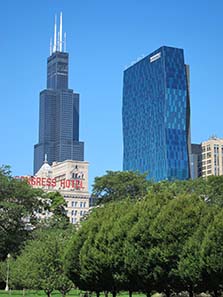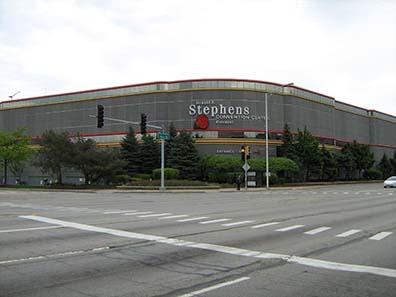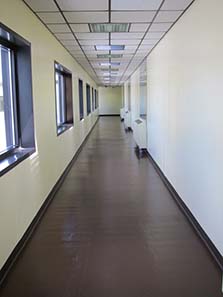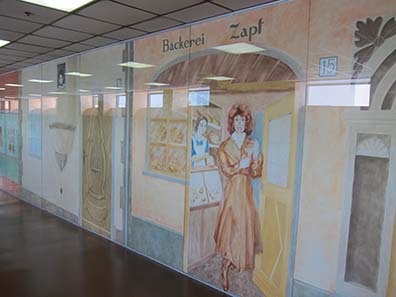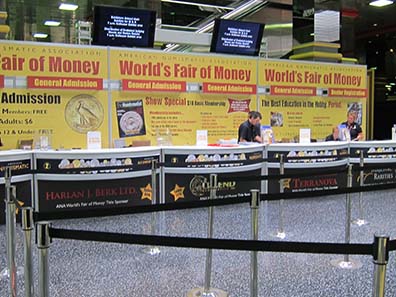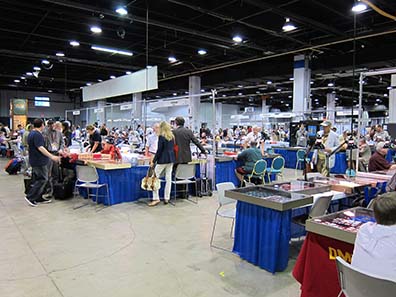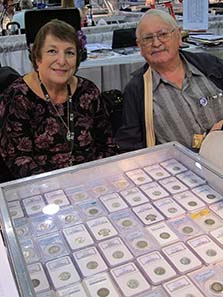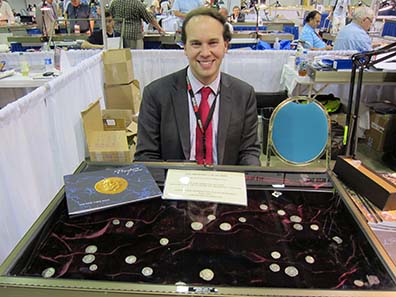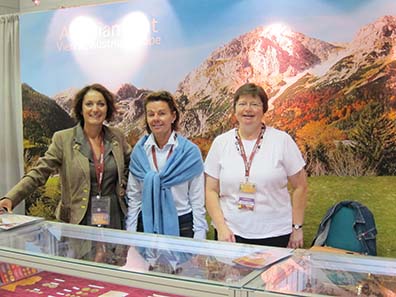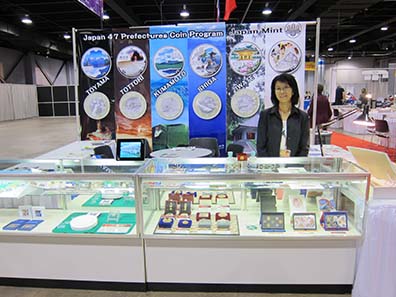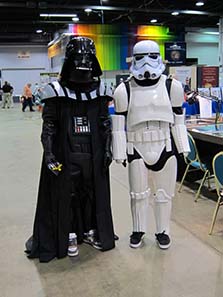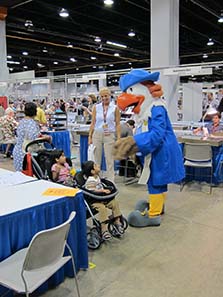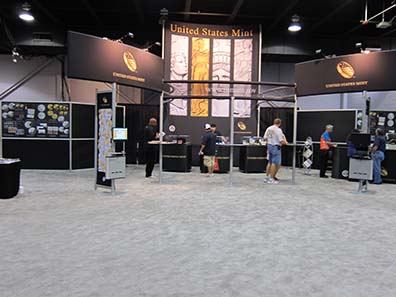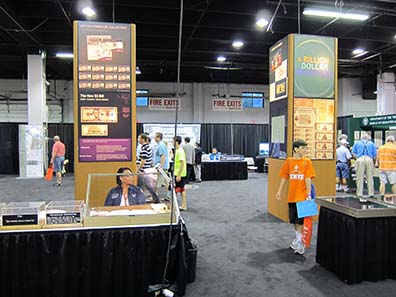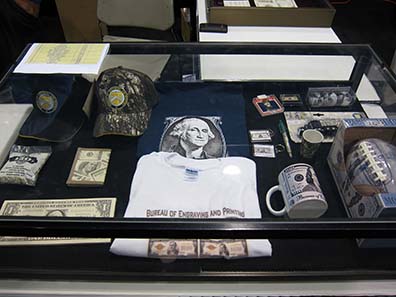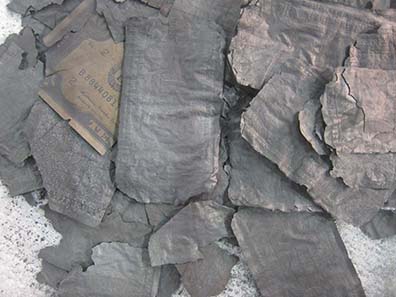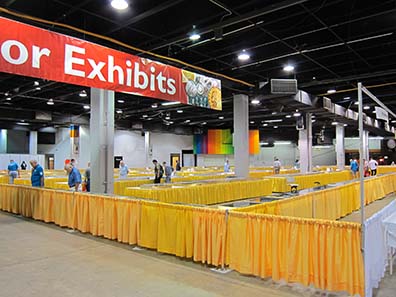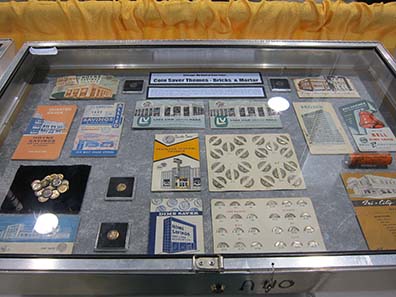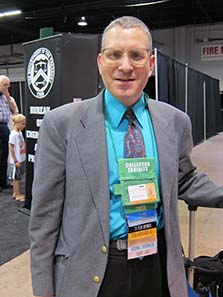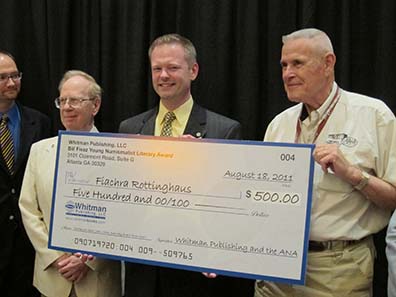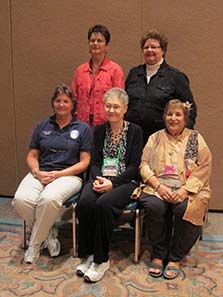by Ursula Kampmann
September 1, 2011 – From August 16 to 20, 2011, the World’s Fair of Money of the American Numismatic Association was conducted near Chicago Airport. It was a typically American fair as a European can hardly imagine.
Supersized – this is the motto not only for Chicago’s skyscrapers, likewise the fair was larger than life. Photograph: UK.
The duration alone: 5 days were scheduled for the fair officially. Anyone not being satisfied with that was free to start already on Friday, August 12, at 4 p.m. with the pre-show. Added to that, the extended opening hours from 9 a.m. to 6 p.m. made 75 hours in total to spend money. This seems almost never-ending when compared with European fairs that often do with 8 hours.
Donald E. Stephen Convention Center. Photograph: Wikipedia.
Equally as supersized as the duration were the geographical conditions. The Donald E. Stephen Convention Center has 780,000 square meters exhibition space. 780,000 square meters! Not even the roughly 500 exhibitors of the World’s Fair of Money managed to fill that area. Thus, there was a second event conducted.
The way to the Convention Center leads through endless corridors. Photograph: UK.
The Convention Center is connected with two big hotels and the parking garage by corridors that go on for miles. These corridors are narrow, have big windows and are designed for Antarctic thanks to the air-condition – just like the rooms of the coin fair, by the way. Being an energy-conscious German, one has to get used to the fact that one needs a thick coat in spite of an outside temperature of well over 30 degrees Celsius.
A German village right in the middle of Chicago. Photograph: UK.
The endless corridors are made less monotonous by a room that attempts to appear like a German village. After all, around 1870 the Germans were the biggest ethnic group in the city and there still exist a “Germantown” with German specialties and an “Oktoberfest” (annual festival in autumn celebrated in Munich). – Oh yeah, typically American is the easily rinseable glass protection of the paintings. Evidently, people around here are familiar with dealing with graffiti.
Entrance to the coin fair. There is much to be learned from this. Photograph: UK.
The ticket boxes are well-prepared for any rush: ropes are taut for the ones seeking entrance to queue up properly and to avoid crowds.
A view inside the show room. Photograph: UK.
A complete shot of the show room? Forget it. No chance for it is far too big for that. Problem is that despite good business the corridors always appear as no collector was present. High numbers of visitors notwithstanding, people disperse around here.
Jack H. Beymer and his wife, experts on US coins. Photograph: UK.
Many German collectors would have trouble with being denied the opportunity to inspect the objects of a dealer, protected by the general crush, without being addressed. Here, on the ANA there are no secret looks. The dealer welcomes every customer and asks if he can be of service. He is virtually waiting for a chat. After all, a little conversation makes the 74 hours he has to sit behind his table pass a little bit quicker. On the other hand, I haven’t seen anyone pressing a customer to buy. It is a certain matter of course when a customer looks at the goods and leaves the table without buying anything.
The Baldwin table with some pieces from the Prospero Collection. Photograph: UK.
With some tables the reputation is at the fore, like the London auction house Baldwin, which exhibited some coins from the Prospero Collection to be auctioned in January in New York. It was as if the British Museum had brought an assortment of its Greek highlights along to the ANA.
The table of the ANS, the American Numismatic Society. Photograph: UK.
The ANA presented an entire section where different American associations of coin collectors won new members. Present were not only ANA and ANS but a number of local societies, too, like the following ones that seem exotic in our view: Philippine Collectors Forum, Liberty Seated Collectors Club or International Organization of Wooden Money Collectors.
The box of the Austrian Mint with its charming representatives. Photograph: UK.
Some mints likewise participated, like the Austrian Mint with an impressive box situated right at the entrance. It was impossible to disregard the imposing mountain setting.
Japan Mint box. Photograph: UK.
And the smile waiting at the box of Japan Mint was simply unbeatable. The main business of the mints wasn’t done in the show room, at that. Whereas only a few mints had set up their own box, many representatives of the individual countries could be found in the different hotel lobbies carrying on business negotiations.
Page service of the ANA. Photograph: UK.
No European fair has this high number of volunteers integrated in the organization. A particularly charming feature is the page service. Boys and girls, clad in red capes with the ANA, assist the coin dealers with carrying out errands or cleaning the glass showcases to get themselves a bit of pin money.
Darth Vader promoting a new coin series from New Zealand. Photograph: UK.
I hope that these young boys in their costumes earn more. Their guise must have been broiling! The two characters form Star Wars promoted New Zealand Mint which had issued a series on the battle of stars.
Advertising character for the US Mint. Photograph: UK.
This advertising character belongs to a number of comic characters the US Mint had developed for kids. The Mint offers a comprehensive program on its website with which it wants to introduce them to collecting.
The box of the US Mint. Photograph: UK.
Likewise the box of the US Mint was impressive. They had giveaways, leaflets and a presentation of the latest coins.
The box of the Bureau of Engraving and Printing. Photograph: UK.
The box of the Bureau of Engraving and Printing, however, easily put the US Mint in the shade.
Souvenirs of the Bureau of Engraving and Printing. Photograph: UK.
There were a lottery, an old coining press, an exhibition and a whole range of souvenirs: my favorites are the golf balls with the banknote design. Unfortunately, I haven’t discovered a way to buy these products on the internet.
Dollar notes after a water damage. Photograph: UK.
Have you ever thought about what to do with a small fortune in banknotes after they had been damaged by water, eaten by mice or destroyed by fire?
Dollar notes destroyed by fire. Photograph: UK.
In the Unites States, you redeem such money at the Bureau of Engraving and Printing. They have a section where it is put together again to verify the loss for the owner to be redeemable.
The exhibition space of the World’s Fair of Money. Photograph: UK.
Speaking of exhibiting: the ANA arranges a contest that provides its members with the opportunity to introduce their particular collecting field to a broader audience.
Money boxes made of paper – they come in all designs possible. Photograph: UK.
It is impressive to see what is presented in the context of this exhibiting contest. Everybody makes an effort to present his collecting field to the visitor as thoroughly as possible. Particularly impressive to me were these “money boxes”, simple sheets of paper in which coins were put in a period of time when these coins were still of value.
Showcase with the winner. Photograph: UK.
The proud winners are decorated with a ribbon.
Please notice the name tag. Photograph: UK.
Ah well, decorations. This is one of the things that are truly exotic to a European. Please notice the extensive name tag this gentleman is wearing around the neck. It sends an immediate signal to the opposite who he is dealing with, i.e. with an exhibitor who is a member of the ANA for 25 years and executes several offices.
Prize giving ceremony of the ANA. Photograph: UK.
That takes us to the reason as to why the World’s Fair of Money takes such a long time. It merely provides the background for any number of activities, such as lectures as well as prize giving ceremonies for anyone who has rendered outstanding service to numismatics in general and his society in particular. Even when I add up all European prizes I end up with not even a fraction of the prizes that are awarded during a single ceremony of the ANA over the course of two hours. There are prizes for the best, the second best, and the third best article in God knows how many categories. Decorated are the ones who had recruited the most new member for the ANA (and the number I heard in this context are truly spectacular!). They have a prize for the most important junior numismatists etc. etc. etc…
The meeting of WIN: Women in Numismatics. Photograph: UK.
Of course, many societies take the opportunity to gather. I visited the meeting of WIN, Women in Numismatics. Yes, they have something like that in the United States and I am seriously reflecting about whether a European branch ought to be founded.
The auctions play a decisive role as well. Photograph: UK.
Apart from the many events to be squeezed in the five auction days, there are of course the auctions where not only thousands of coins are sold. They are the main source of income of the fair host. After all, the auctioneer pays for the opportunity to conduct his auction in the context of the fair.
And that’s it from Chicago. By the way, a funny detail on our own account may be added. That the World’s Fair of Money chose its name referring to a German coin show is fairly obvious to insiders. By now, there is an also an American online publication that selected its new name “Coin Week” following CoinsWeekly which had been published for some time then.
Its appearing in the ANA program with that very name testifies once again that it is quality that makes a product widely known, not a name.




